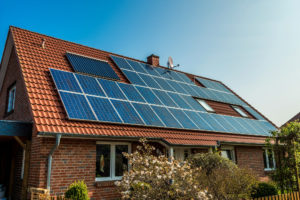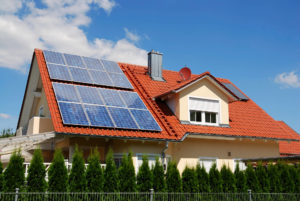The solar industry is at the forefront of the global clean energy revolution, pivotal in transitioning to a sustainable and decarbonized future. Harnessing the sun’s power, solar energy offers a renewable and environmentally friendly alternative to traditional fossil fuel-based power generation. This article will delve into the various aspects of the solar industry, from solar panels to market trends, installation processes, economic impact, and prospects.
Contents
- 1 Key Takeaways
- 2 Solar Energy: An Overview
- 3 Solar Panels: The Backbone of Solar Power
- 4 Solar Industry Growth and Market Trends
- 5 Solar Panel Installation: A Step Towards Sustainability
- 6 Solar Thermal Systems: Harnessing the Sun’s Heat
- 7 The Economic Impact of the Solar Industry
- 8 Overcoming Challenges and Future Prospects
- 9 Case Study: Implementing Solar Power Solutions for a Sustainable Future
- 10 Expert Insights From Our Solar Panel Installers About The Solar Industry
- 11 Experience Solar Excellence with Us!
- 12 Conclusion
- 13 FAQ
Key Takeaways
- Solar energy is a clean, renewable power source harnessed through photovoltaic (PV) technology and concentrating solar power (CSP) systems.
- Solar panels are essential for solar power systems, converting sunlight into electricity through the photovoltaic effect.
- The solar industry is experiencing rapid growth, driven by increasing demand, technological advancements, and the economic benefits it brings, including job creation and investment opportunities.
Solar Energy: An Overview
Understanding Solar Energy
Solar energy, also called solar power, is a form of renewable energy derived from the sun’s radiation. The sun releases vast amounts of energy, and solar power harnesses this energy to generate electricity and heat. It is a clean and sustainable energy source that produces no greenhouse gas emissions during operation.
Photovoltaic (PV) Technology
At the heart of solar energy generation are solar panels, which utilize photovoltaic (PV) technology. PV cells, made of semiconducting materials like silicon, absorb photons from sunlight and convert them into direct current (DC) electricity through the photovoltaic effect. Multiple PV cells are connected to form solar panels, which can be installed on rooftops, in solar farms, or integrated into building structures.
Concentrating Solar Power (CSP)
Another method of harnessing solar energy is Concentrating Solar Power (CSP) systems. CSP uses mirrors or lenses to concentrate sunlight onto a receiver, typically a fluid-filled pipe or a tower. The concentrated heat is then used to produce steam, which drives a turbine to generate electricity. CSP is often used in utility-scale solar power plants because it can generate power even when sunlight is limited.
Solar Panels: The Backbone of Solar Power
Composition and Structure
Solar panels consist of several layers and components. The top layer is typically a protective glass cover that allows sunlight to pass through while safeguarding the internal components. Beneath the glass are photovoltaic cells, which are interconnected and encapsulated in a weather-resistant material, such as ethylene-vinyl acetate (EVA). The backside of the solar panel is usually covered with a polymer or aluminum sheet for additional protection and support.
Working Principles
When sunlight strikes the surface of a solar panel, the PV cells absorb photons and generate an electric current. This direct current is collected by conductive metal strips on the cells and channeled into a junction box on the panel. The junction box houses electrical connections that allow the generated electricity to be collected, used, or fed into the electrical grid.
Types of Solar Panels
Solar panels come in various types, including monocrystalline, polycrystalline, and thin-film. Monocrystalline panels are made from a single crystal structure, providing high efficiency but at a higher cost. Polycrystalline panels consist of multiple crystals and offer slightly lower efficiency but are more cost-effective. Thin-film panels use a different manufacturing process, resulting in lower efficiency but greater flexibility and lower production costs.

Solar Industry Growth and Market Trends
Increasing Demand for Solar Power
The solar industry has experienced significant growth worldwide due to several factors. Growing awareness about climate change and the need for clean energy has fueled the demand for solar power. Additionally, declining costs of solar panels, government incentives, and supportive policies have made solar installations more accessible and attractive to residential, commercial, and utility-scale consumers.
Market Expansion and Technological Advancements
Solar power installations have witnessed remarkable growth, with increasing numbers of solar projects and installations of solar panels. Utility-scale solar farms are becoming more prevalent, contributing to the expansion of renewable energy generation. Furthermore, advancements in solar technology, such as improved panel efficiency, energy storage solutions, and grid integration, are enhancing solar systems’ overall performance and viability.
Job Creation and Economic Impact
The solar industry’s growth has led to job creation and economic benefits. As the demand for solar installations rises, so does the need for skilled professionals in design, installation, maintenance, and manufacturing. The solar industry’s expansion creates employment opportunities, stimulates local economies, and attracts investments in renewable energy projects. Moreover, the solar industry helps reduce reliance on fossil fuel imports, improving energy security and promoting a more sustainable energy mix.
Solar Panel Installation: A Step Towards Sustainability
Site Assessment and Design
Solar panel installation begins with a comprehensive site assessment, evaluating factors such as available sunlight, shading, roof orientation, and structural integrity. Designing a solar system involves determining the optimal number and arrangement of solar panels, considering energy consumption patterns, local regulations, and electrical grid compatibility.
Permitting and Equipment Procurement
Obtaining necessary permits and approvals from local authorities is essential before solar panel installation. This includes securing permits for grid connection, structural assessments, and compliance with building codes and regulations. Once permits are obtained, equipment procurement involves selecting and purchasing solar panels, inverters, racking systems, wiring, and other necessary components.
Professional Installation and Safety Considerations
Solar panel installation should be done by qualified professionals knowledgeable about electrical systems and safety practices. Installation typically involves mounting the panels securely on rooftops or ground-mounted structures, connecting the panels in series or parallel configurations, and wiring the system to the inverter and electrical distribution board. Safety measures, such as proper grounding and electrical insulation, are essential to ensure safe and reliable operation.
Grid Connection and Net Metering
After the installation, the solar system is connected to the electrical grid through an inverter. The inverter converts the DC electricity produced by the solar panels into usable AC electricity. Net metering allows excess electricity generated by the solar system to be fed back into the grid, earning credits that can offset electricity consumption during periods of low solar generation. This ensures seamless integration of solar power with the existing electrical infrastructure.

Solar Thermal Systems: Harnessing the Sun’s Heat
Solar Water Heating
Solar thermal systems, specifically solar water heating systems, utilize the sun’s heat to provide hot water for domestic or commercial use. These systems typically consist of solar collectors, storage tanks, circulation pumps, and controls. The collectors capture the sun’s heat and transfer it to a heat transfer fluid to the water stored in the tanks. Solar water heating systems offer an energy-efficient, cost-effective alternative to conventional water heating methods.
Solar Space Heating
Solar thermal technology can also be used for space heating, where the captured solar heat is directly transferred to heat the air within a building or space. This can be achieved through systems like air collectors or solar walls, which absorb solar radiation and transfer the heat to the air, circulating it throughout the building. Solar space heating reduces the reliance on fossil fuel-based heating systems, resulting in energy savings and lower carbon emissions.
The Economic Impact of the Solar Industry
Job Creation and Employment Opportunities
The solar industry’s rapid growth has led to substantial job creation and employment opportunities. Solar installations require skilled workers, including system designers, installers, electricians, project managers, and maintenance technicians. As the industry expands, it contributes to local economies by providing sustainable employment and supporting related industries, such as manufacturing, research, and development.
Investment Opportunities and Economic Development
The solar industry presents attractive investment opportunities for individual investors and institutional funds. Investing in solar projects and companies offers long-term returns, promotes sustainable development, and aligns with environmental, social, and governance (ESG) goals. Solar projects contribute to economic development by attracting investments, fostering innovation, and stimulating local businesses in the supply chain.
Energy Independence and Reduced Fossil Fuel Dependency
The solar industry is crucial in reducing reliance on imported fossil fuels. By generating clean and renewable electricity, solar power contributes to energy independence and strengthens energy security. Countries and regions with abundant solar resources can diversify their energy mix, reducing the risks associated with fossil fuel price volatility and geopolitical factors.
Overcoming Challenges and Future Prospects
Intermittency and Grid Integration
One of the challenges solar power faces is its intermittency, as solar generation is dependent on sunlight availability. However, advancements in energy storage technologies, such as batteries, enable the storage of excess solar energy for use during periods of low solar generation. Grid integration solutions, including smart grid systems and demand response programs, facilitate solar power’s effective management and integration into existing electrical grids.
Technological Advancements and Cost Reductions
The solar industry continues to witness significant technological advancements, leading to increased efficiency, durability, and cost reductions. Research and development efforts focus on improving PV cell efficiency, exploring new materials, and enhancing manufacturing processes. Innovations in solar technology and economies of scale contribute to further cost reductions, making solar power increasingly competitive with conventional energy sources.
Promising Future Prospects
The solar industry’s future appears bright, with ongoing growth and potential. Solar power can meet substantial global electricity demand, especially as renewable energy targets and climate change mitigation efforts gain momentum. Continued investments in research, development, and deployment of solar technologies will drive further advancements, making solar power an indispensable component of the global energy transition.
Case Study: Implementing Solar Power Solutions for a Sustainable Future
Background
At Solar Panels Network USA, we pride ourselves on delivering top-tier solar solutions to a diverse clientele, ranging from residential homeowners to large commercial enterprises. One of our recent projects involved a mid-sized manufacturing company keen to reduce its carbon footprint and operational costs by transitioning to solar energy.
Project Overview
The manufacturing company sought to install a solar power system that would offset a significant portion of its electricity consumption. The primary goals were to achieve energy independence, reduce electricity costs, and demonstrate a commitment to environmental sustainability. Our team conducted a comprehensive site assessment to design a system tailored to the company’s energy needs and site conditions.
Implementation
Site Assessment and System Design
We began with a detailed site assessment, evaluating the roof space, structural integrity, and sunlight exposure. The design phase involved creating a custom solar solution that included a mix of rooftop and ground-mounted solar panels. We selected high-efficiency monocrystalline panels for their superior performance and durability.
Permitting and Equipment Procurement
Navigating the permitting process was crucial to ensuring compliance with local regulations. We worked closely with local authorities to secure all necessary permits. Concurrently, we procured the solar panels, inverters, and mounting systems, ensuring all components met industry standards for quality and efficiency.
Professional Installation
Our certified installation team carried out the installation, adhering to stringent safety protocols and best practices. The solar panels were securely mounted, and the electrical connections were meticulously checked to ensure optimal performance and safety. The installation also included an advanced inverter system to convert the generated DC power to usable AC power, seamlessly integrating with the company’s electrical grid.
Grid Connection and Monitoring
Post-installation, the system was connected to the grid, and we implemented a net metering arrangement. This allowed the company to feed excess electricity back into the grid, earning credits to offset future electricity use. We also installed a state-of-the-art monitoring system to track the solar array’s performance in real-time, enabling the company to optimize energy use and maintenance schedules.
Results
Energy Savings and Environmental Impact
The solar power system generated significant energy savings, reducing the company’s electricity bills by over 60%. The switch to solar power also led to a substantial reduction in carbon emissions, aligning with the company’s sustainability goals and enhancing its corporate social responsibility profile.
Economic Benefits
The project resulted in direct financial savings from reduced electricity costs and indirect benefits, such as enhanced brand reputation and increased customer loyalty. Additionally, the company qualified for federal tax credits and state incentives, further improving the return on investment.
Community and Industry Influence
The successful implementation of the solar power system set a positive example within the local business community. It encouraged other businesses to explore renewable energy options, fostering a broader commitment to sustainability in the region.
Summary
This case study exemplifies the transformative impact of solar energy on commercial operations. By partnering with Solar Panels Network USA, the manufacturing company achieved significant cost savings, enhanced its environmental stewardship, and inspired others to pursue sustainable energy solutions. Our expertise in designing and implementing tailored solar solutions ensures that businesses can confidently transition to clean energy and reap the associated benefits.
Expert Insights From Our Solar Panel Installers About The Solar Industry
The advancements in photovoltaic technology have significantly boosted the efficiency and affordability of solar panels, making solar power more accessible to a broader audience.
Chief Solar Technology Engineer
As the demand for renewable energy grows, we see a corresponding increase in job opportunities across various sectors of the solar industry, from manufacturing to installation and maintenance.
Lead Solar Installation Technician
The economic benefits of solar power extend beyond energy savings for homeowners and businesses; they also include job creation and the stimulation of local economies through new investments in renewable energy infrastructure.
Solar Project Development Manager
Experience Solar Excellence with Us!
Trust in Solar Panels Network USA, where our seasoned experts deliver top-quality solar solutions for homes and businesses nationwide. With a legacy of countless successful installations and a commitment to sustainable energy, we’re your reliable partner in the solar journey. Ready for a brighter, eco-friendly future? Call us now at (855) 427-0058 and harness the power of the sun!
Conclusion
The solar industry is a key driver in transitioning to a cleaner, more sustainable energy future. Solar power harnessed through solar panels and thermal systems, offers a renewable and eco-friendly energy source. As we continue to embrace solar energy, its widespread adoption will play a vital role in reducing carbon emissions, mitigating climate change, and ensuring a greener planet for future generations.
FAQ
Is solar a booming industry?
The solar industry is experiencing significant growth and is considered a booming industry globally. The increasing adoption of solar power, declining costs, and supportive policies have contributed to its rapid expansion.
What type of industry is solar?
Solar is a renewable energy industry that harnesses the sun’s power to generate electricity and heat. It encompasses various sectors, including solar panel manufacturing, installation, project development, and research and development.
How profitable is the solar industry?
The profitability of the solar industry can vary depending on factors such as market conditions, project scale, and location. With the right business model and market opportunities, solar companies and investors can achieve attractive returns on investments in solar projects.
Is solar in demand?
Yes, solar power is in high demand. The increasing awareness of the need for clean energy and sustainable solutions, coupled with declining costs, has driven the demand for solar installations across residential, commercial, and utility-scale sectors. The growing emphasis on reducing carbon emissions and mitigating climate change further fuels the demand for solar energy.
About the Author
Solar Panels Network USA stands at the forefront of solar energy solutions, driven by a team of seasoned solar engineers and energy consultants. With over decades of experience in delivering high-quality solar installations and maintenance, we are committed to promoting sustainable energy through customer-centric, tailored solutions. Our articles reflect this commitment, crafted collaboratively by experts to provide accurate, up-to-date insights into solar technology, ensuring our readers are well-informed and empowered in their solar energy decisions.

